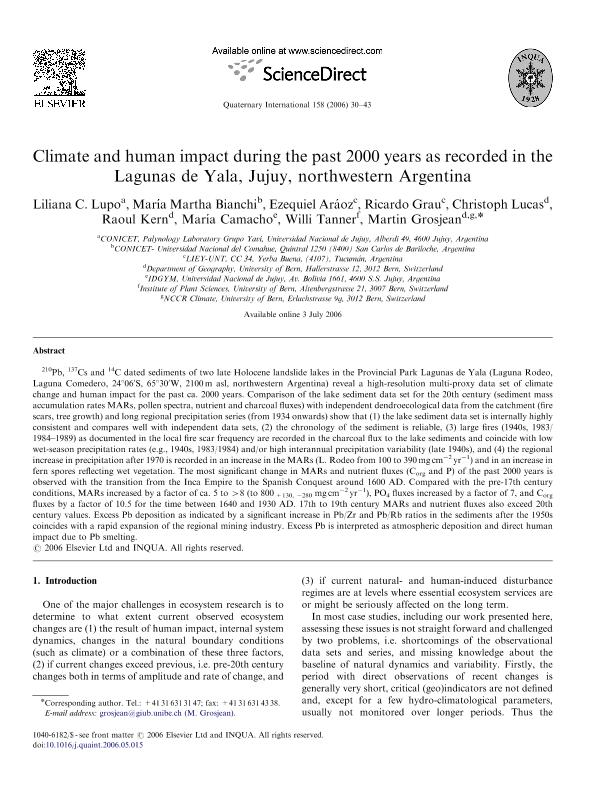Artículo
Climate and human impact during the past 2000 years as recorded in the Lagunas de Yala, Jujuy, northwestern Argentina
Lupo, Liliana Concepcio; Bianchi, Maria Martha ; Aráoz, Ezequiel
; Aráoz, Ezequiel ; Grau, Hector Ricardo
; Grau, Hector Ricardo ; Lucas, Christoph; Kern, Raoul; Camacho, María; Tanner, Willi; Grosjean, Martin
; Lucas, Christoph; Kern, Raoul; Camacho, María; Tanner, Willi; Grosjean, Martin
 ; Aráoz, Ezequiel
; Aráoz, Ezequiel ; Grau, Hector Ricardo
; Grau, Hector Ricardo ; Lucas, Christoph; Kern, Raoul; Camacho, María; Tanner, Willi; Grosjean, Martin
; Lucas, Christoph; Kern, Raoul; Camacho, María; Tanner, Willi; Grosjean, Martin
Fecha de publicación:
12/2006
Editorial:
Pergamon-Elsevier Science Ltd
Revista:
Quaternary International
ISSN:
1040-6182
Idioma:
Inglés
Tipo de recurso:
Artículo publicado
Clasificación temática:
Resumen
210Pb, 137Cs and 14C dated sediments of two late Holocene landslide lakes in the Provincial Park Lagunas de Yala (Laguna Rodeo, Laguna Comedero, 24°06′S, 65°30′W, 2100 m asl, northwestern Argentina) reveal a high-resolution multi-proxy data set of climate change and human impact for the past ca. 2000 years. Comparison of the lake sediment data set for the 20th century (sediment mass accumulation rates MARs, pollen spectra, nutrient and charcoal fluxes) with independent dendroecological data from the catchment (fire scars, tree growth) and long regional precipitation series (from 1934 onwards) show that (1) the lake sediment data set is internally highly consistent and compares well with independent data sets, (2) the chronology of the sediment is reliable, (3) large fires (1940s, 1983/1984-1989) as documented in the local fire scar frequency are recorded in the charcoal flux to the lake sediments and coincide with low wet-season precipitation rates (e.g., 1940s, 1983/1984) and/or high interannual precipitation variability (late 1940s), and (4) the regional increase in precipitation after 1970 is recorded in an increase in the MARs (L. Rodeo from 100 to 390 mg cm-2 yr-1) and in an increase in fern spores reflecting wet vegetation. The most significant change in MARs and nutrient fluxes (Corg and P) of the past 2000 years is observed with the transition from the Inca Empire to the Spanish Conquest around 1600 AD. Compared with the pre-17th century conditions, MARs increased by a factor of ca. 5 to >8 (to 800 +130, -280 mg cm-2 yr-1), PO4 fluxes increased by a factor of 7, and Corg fluxes by a factor of 10.5 for the time between 1640 and 1930 AD. 17th to 19th century MARs and nutrient fluxes also exceed 20th century values. Excess Pb deposition as indicated by a significant increase in Pb/Zr and Pb/Rb ratios in the sediments after the 1950s coincides with a rapid expansion of the regional mining industry. Excess Pb is interpreted as atmospheric deposition and direct human impact due to Pb smelting. © 2006 Elsevier Ltd and INQUA.
Archivos asociados
Licencia
Identificadores
Colecciones
Articulos(CCT - NOA SUR)
Articulos de CTRO.CIENTIFICO TECNOL.CONICET - NOA SUR
Articulos de CTRO.CIENTIFICO TECNOL.CONICET - NOA SUR
Articulos(IBIGEO)
Articulos de INST.DE BIO Y GEOCIENCIAS DEL NOA
Articulos de INST.DE BIO Y GEOCIENCIAS DEL NOA
Articulos(INIBIOMA)
Articulos de INST. DE INVEST.EN BIODIVERSIDAD Y MEDIOAMBIENTE
Articulos de INST. DE INVEST.EN BIODIVERSIDAD Y MEDIOAMBIENTE
Articulos(SEDE CENTRAL)
Articulos de SEDE CENTRAL
Articulos de SEDE CENTRAL
Citación
Lupo, Liliana Concepcio; Bianchi, Maria Martha; Aráoz, Ezequiel; Grau, Hector Ricardo; Lucas, Christoph; et al.; Climate and human impact during the past 2000 years as recorded in the Lagunas de Yala, Jujuy, northwestern Argentina; Pergamon-Elsevier Science Ltd; Quaternary International; 158; 1; 12-2006; 30-43
Compartir
Altmétricas



